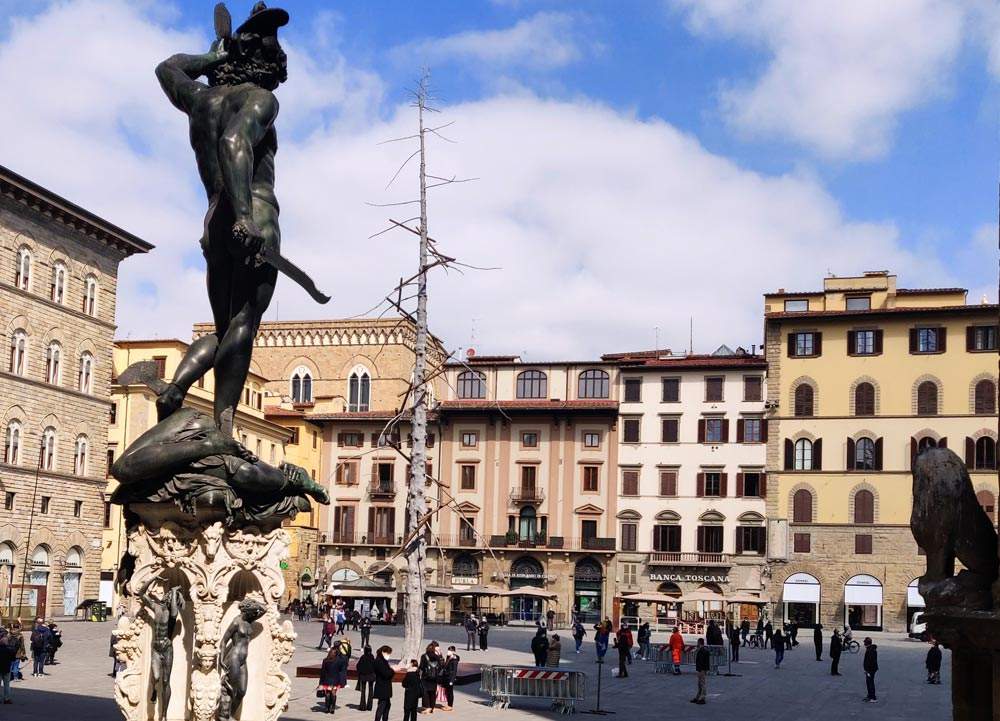A 22-meter-high steel and bronze tree in Florence’s Piazza della Signoria: it is the work by Giuseppe Penone(here is a detailed discussion of his art) with which the city and the Uffizi Galleries pay homage to Dante Alighieri on the occasion of Danteedi, the day designed to celebrate the Supreme Poet on the anniversary of the beginning of the journey of the Divine Comedy (whose narrative begins on March 25, 1300). Curated by the Uffizi in co-promotion with the City, it is the largest sculpture ever housed in public space in the historic center of Florence. The work is a precursor to the Alberi In-versi exhibition, featuring creations by the Turin-based master, dedicated to Dante Alighieri and housed in the spaces of the Uffizi Galleries from June 1 to Sept. 12.
The colossal sculpture, titled Abete, is meant to be a metaphor for Paradise: “the tree that lives of the top / and bears fruit always and never loses leaf” (vv. 29-30, Canto XVIII, Paradiso, Divine Comedy), as Cacciaguida degli Elisei states to describe to the incredulous Dante Alighieri the place where he is. For Penone, the tree is an image of a youth spent in the woods of the Maritime Alps, assiduously frequented in the now more than fifty years of research. Through its growth in concentric circles, the tree reveals an essential form, strictly necessary to its very existence and development, since it has its roots in the earth but its branches raised toward the sky. The fir tree, a conifer, is a plant that is characterized by a trunk resistant to twisting and by stage-like branches with a regular course: according to Penone, it is, in short, a formal synthesis of the very idea of a tree. For these reasons, the work Penone has chosen to place in Piazza della Signoria is a monumental fir. Fir, the artist explains, “indicates the development of thought, which is similar to the growth spiral of the vegetable.”
The trunk and branches of the fir tree were made of cast stainless steel, wrapped in a lattice that gives the installation an ascending sense: the 18 elements that form it were molded in bronze, using a casting process from bamboo casts. Abete reveals Giuseppe Penone’s interest in the environmental aspects of art, especially in urban space: here, according to the artist, is where the continuity between culture and nature, between the time of history and that of life, between past and present, unfolds, even in a place as strongly connoted as Piazza Signoria in Florence.
“Contemporary art in Piazza della Signoria has known even heated debates, ever since the days of Michelangelo’s David and Baccio Bandinelli’s Hercules and Cacus,” says Eike Schmidt, director of the Uffizi. “This has always been a sign of the liveliness of the Florentines, who will now be able to ponder (and why not, polemicize) the many meanings of Penone’s installation. The fact remains, however, that this ’Dantean tree,’ which in the artist’s intention refers to the verses of Alighieri, mixes an abstract idea of nature (not coincidentally made of metal) with the all-petrous concreteness of the center of Florence.”
“The tree by its very nature turns its gaze toward the sky, toward those stars coveted by Dante, toward salvation,” stresses the mayor of Florence, Dario Nardella. “What better symbol then, in this dramatic year, of a hope for rebirth and restart after the pandemic? Florence celebrates its Poet and its New Year with this icon in its main square, which for several years has been the scene of contemporary public art, as a signal of restarting, starting with culture, art and nature. This work and in general the 700th anniversary events will be not only a unique occasion to celebrate the Supreme Poet but also a form of reconciliation of his city towards a citizen first so neglected and then so regretted, and a way to deal with his extraordinary and still relevant legacy in a 360-degree way. A legacy that passes through the museum of the language in Santa Maria Novella, the cenotaph in Santa Croce, the readings of the tercets read in every part of the world, the tombstones and sculptures that commemorate the Poet and the Comedy, and the myriad events that we are preparing to organize in the sign of a figure who has become a universal symbol.”
“Trees, a cherished theme in Penone’s work,” says City of Florence Culture Councillor Tommaso Sacchi, “are also among the fundamental symbols in the Divine Comedy, from the initial forest to the upturned tree in Paradise. Having in our main square a Fir tree that stands tall and induces us to raise our eyes to a renewed horizon is our choice to celebrate Dante with contemporary art and public art in general of which Florence has been an active experimenter for some years now. What is striking about Dante is his universality: we have all been confronted, in various forms, with the Divine Comedy and other works, and his is a fantastical and spiritual journey that is powerfully relevant today. In the year of rebirth after Covid tying Dante to a natural symbol can be a way of rethinking deep down a new relationship between man and nature but also between man and art, poetry, culture, all cardinal values and beacons of light that guide us on the road to restart.”
 |
| Florence, Penone's Fir tree installed in Piazza della Signoria, a tribute to Dante |
Warning: the translation into English of the original Italian article was created using automatic tools. We undertake to review all articles, but we do not guarantee the total absence of inaccuracies in the translation due to the program. You can find the original by clicking on the ITA button. If you find any mistake,please contact us.